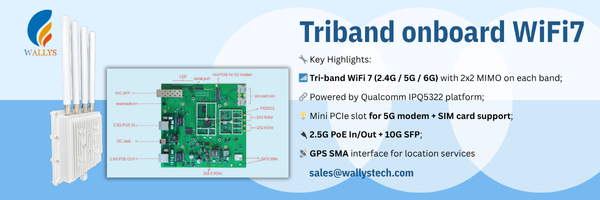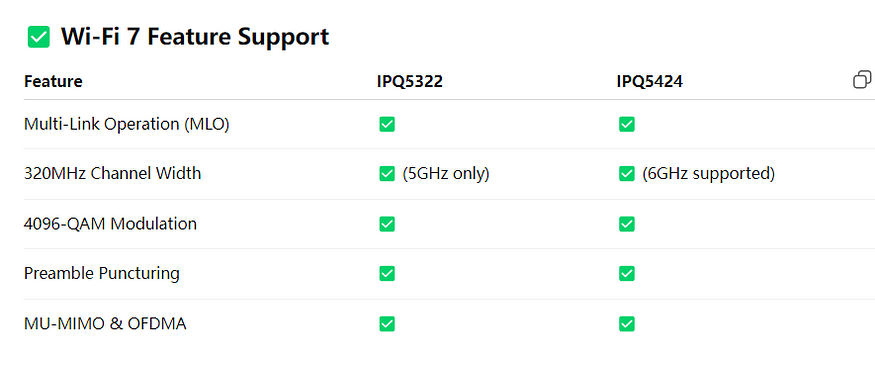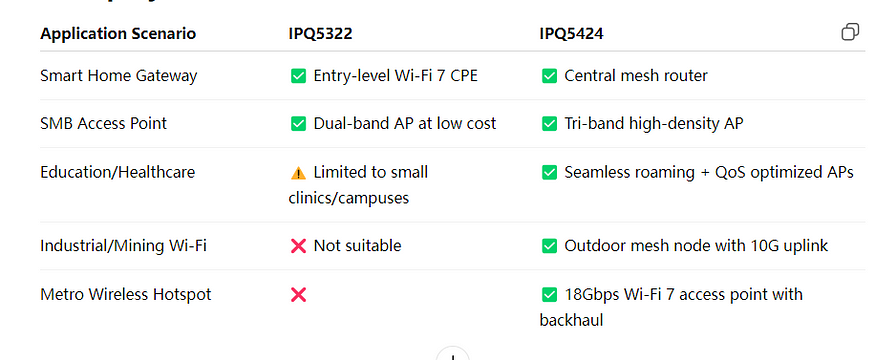As digital transformation and the Internet of Everything accelerate, Wi-Fi has evolved from a simple convenience to mission-critical infrastructure. Starting in 2024, Wi-Fi 7 (802.11be) enters commercial deployment, bringing groundbreaking features like ultra-high bandwidth, low latency, and Multi-Link Operation (MLO). These innovations unlock new possibilities in high-density, high-demand networking environments.
sales@wallystech.com
Qualcomm’s IPQ5322 and IPQ5424 SoCs are purpose-built for this evolution, targeting mid-range and high-performance markets respectively. This article provides an in-depth look at their architecture, wireless capabilities, system performance, I/O design, software support, and real-world applications.
1. Architecture: Built for Wi-Fi 7 from the Ground Up


- IPQ5322: Designed for dual-band Wi-Fi 7 routers or cost-sensitive mesh devices, focusing on energy efficiency and simplicity.
- IPQ5424: A premium-tier SoC in the Qualcomm Pro 820 series, featuring a 6nm process and powerful CPU cores for advanced applications like enterprise APs, 5G backhaul nodes, and high-performance mesh routers.
2. Wireless Capabilities: Full Wi-Fi 7 Feature Set
✅ Wi-Fi 7 Feature Support

📡 RF Configuration
- IPQ5322: Integrated 2x2@2.4GHz + 2x2@5GHz radios, no external RF needed — ideal for simplified hardware BOM.
- IPQ5424: Supports 4x4@2.4GHz + 4x4@5GHz + 4x4@6GHz via external radios like QCN9274 or QCN6274, delivering up to 18Gbps peak PHY rate — perfect for high-density, tri-band applications.
3. Processing Power & Interfaces: Designed for Performance
💻 CPU and Network Acceleration
- IPQ5322: Dual-core CPU is sufficient for NAT, firewall, QoS, and smart home gateway use.
- IPQ5424: High-performance design enables advanced packet processing, DPI, SD-WAN, and integration with edge AI.
🔌 I/O and Expansion

4. Software Ecosystem: Ready for OpenWRT and OpenWiFi
- IPQ5322 is already supported in several OpenWRT branches and is ideal for open-source routers, IoT gateways, and SMB APs.
- IPQ5424 is being actively integrated into the OpenWiFi ecosystem, with strong support from ODMs like Wallys, Edgecore, and Hawkeye. It runs on Qualcomm’s SDK 7.x and supports SDN/NFV-based cloud management architectures.
5. Deployment Scenarios

6. Featured Products Based on IPQ5322 / IPQ5424
IPQ5322-based devices:
- Wallys DR531
- AsiaRF AW7916-NPD
- GL.iNet Wi-Fi 7 entry-level routers (in development)
IPQ5424-based devices:
- Wallys DR54X9 (tri-band design)
- Edgecore EAP107 series enterprise APs
- Carrier-grade 5G backhaul CPEs (with QCN9274 RF module)
Many manufacturers have recognized IPQ5424 as the go-to tri-band Wi-Fi 7 platform, especially for markets prioritizing 6GHz support such as North America, Europe, Japan, and South Korea.
7. Conclusion: A Flexible SoC Duo for All Wi-Fi 7 Needs
Qualcomm’s dual-chip strategy with the IPQ5322 and IPQ5424 enables developers and OEMs to address both cost-sensitive and performance-critical Wi-Fi 7 markets:
- IPQ5322 targets entry-level and mid-range dual-band deployments with integrated radios.
- IPQ5424 offers unmatched flexibility and speed for tri-band, enterprise-class, or industrial-grade networks.
The key to selecting between these SoCs lies in the deployment scenario: does the project require tri-band operation, 6GHz capability, ultra-high bandwidth, or multi-node mesh support? Understanding those real-world requirements is the foundation for choosing the optimal Wi-Fi 7 chipset.
Comments
Post a Comment